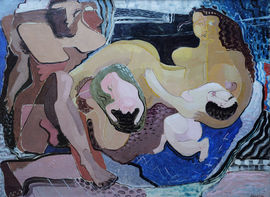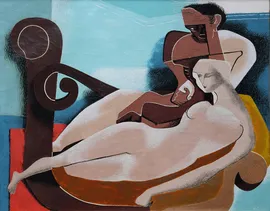Blair Hughes-Stanton (1902-1981)
Blair Rowlands Hughes-Stanton (22 February 1902 – 6 June 1981) was a major figure in the English wood-engraving revival in the twentieth century. He was the son of the artist Sir Herbert Hughes-Stanton. He exhibited with the Society of Wood Engravers, but was more in sympathy with the philosophy of the English Wood Engraving Society, of which he was a founding member in 1925. He co-directed the Gregynog Press from 1930 to 1933 with his wife, Gertrude Hermes. Hughes Stanton was one of the most acclaimed artists in Britain during the interwar era, known for his role in the revival of wood engraving in Modern art. He studied under Leon Underwood at his Brook Green School alongside Henry Moore and Eileen Agar, where he developed a unique visual language, creating works that were a celebration of love and physicality. Alongside his first wife, Gertrude Hermes, Hughes Stanton became a much sought-after book illustrator, his wood engravings featuring in books by his friend D.H. Lawrence and T.E. Lawrences 'Seven Pillars of Wisdom'. The Myth series of paintings relates to the artist's relationship with Ida Graves, poet, novelist and associate of the Bloomsbury Group, with whom Hughes-Stanton started the Gemini Press in 1933. Their first book together was 'Epithalamion: a poem'. At the age of 13 Hughes-Stanton, unable to face the prospect of home life with his three sisters, joined the Royal Navy training ship HMS Coway. At the age of 19 he switched direction completely after a conversation with his father, the Royal Academician Sir Herbert Hughes-Stanton, and joined the Byam Shaw School of Art. There he came under the influence of Leon Underwood and, in 1921, he moved to Underwood's Brook Green School. In 1922 he joined the Royal Academy Schools, but Underwood remained the dominant influence on him. At Brook Green the American wood engraver Marion Mitchell introduced him to wood-engraving, which set the direction of his life. Underwood and he were kindred spirits, to such an extent that, in 1925, Underwood left Hughes-Stanton in charge of the Brook Green School when he went to America. Hughes-Stanton met Eric Kennington, who introduced him to T. E. Lawrence. Hughes-Stanton was commissioned to engrave ten tail-pieces for the monumental limited edition of The Seven Pillars of Wisdom (1926). Some extra special copies had a full-page engraving by Hughes-Stanton for the dedicatory poem to "S.A.". Other commissions followed and, in the next few years, he illustrated with wood engravings three tall folios for the Cresset Press – The Pilgrim's Progress (1928), The Apocrypha (1929) and D. H. Lawrence's Birds, Beasts and Flowers (1930). Although he did some work in oils and spent a great deal of time experimenting with linocuts in his later years, Hughes-Stanton's artistic production consists mostly of wood engravings. He is known for the very fine white lines of his engravings, which presented considerable difficulty to pressmen trying to print his engravings on hard handmade paper. The engravings are frequently of the female form, and contemporary judgements ranged from erotic to pornographic. Towards the end of his career his engravings featured semi-abstract figures. Examples of his fine cutting and individual style can be seen at the British Council website.

